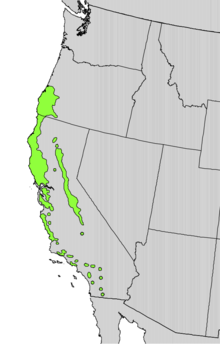| Umbellularia | |
|---|---|

| |
| Foliage and flowers | |
| Scientific classification | |
| Kingdom: | Plantae |
| Clade: | Tracheophytes |
| Clade: | Angiosperms |
| Clade: | Magnoliids |
| Order: | Laurales |
| Family: | Lauraceae |
| Genus: | Umbellularia (C.G.D.Nees) Nuttall |
| Species: | U. californica
|
| Binomial name | |
| Umbellularia californica | |

| |
| Natural range | |
| Synonyms | |
|
Sciadiodaphne Rchb. | |
Umbellularia californica is a large hardwood tree native to coastal forests and the Sierra foothills of California, and to coastal forests extending into Oregon.[2] It is endemic to the California Floristic Province. It is the sole species in the genus Umbellularia.
The tree was formerly known as Oreodaphne californica.[3] In Yuki, it is called pōl’-cum ōl.[4] In Oregon, this tree is known as Oregon myrtle, while in California it is called California bay laurel, which may be shortened to California bay[5] or California laurel. It has also been called pepperwood, spicebush, cinnamon bush, peppernut tree, headache tree,[6] mountain laurel,[7] and balm of heaven.[7]
The tree's pungent leaves have a similar flavor to bay leaves, though stronger, and it may be mistaken for bay laurel. The dry wood has a color range from blonde (like maple) to brown (like walnut). It is considered an excellent tonewood and is sought after by luthiers and woodworkers.
The tree is a host of the pathogen that causes sudden oak death.

- ^ Stritch, L. (2018). "Umbellularia californica". IUCN Red List of Threatened Species. 2018: e.T62572A68077480. doi:10.2305/IUCN.UK.2018-2.RLTS.T62572A68077480.en. Retrieved 19 November 2021.
- ^ "Umbellularia californica (Hook. & Arn.) Nutt". CalFlora. Retrieved 2012-02-05.
- ^ "The Plant List".
- ^ Plants Used by the Indians of Mendocino, California.
- ^ BSBI List 2007 (xls). Botanical Society of Britain and Ireland. Archived from the original (xls) on 2015-06-26. Retrieved 2014-10-17.
- ^ Nassini, R.; et al. (2011). "The 'headache tree' via umbellulone and TRPA1 activates the trigeminovascular system". Brain. 135 (2): 376–90. doi:10.1093/brain/awr272. PMID 22036959.
- ^ a b John Henry Clarke (1986). A Dictionary of Practical Materia Medica. B. Jain Publishers/Médi-T. ISBN 978-81-7021-013-9.
